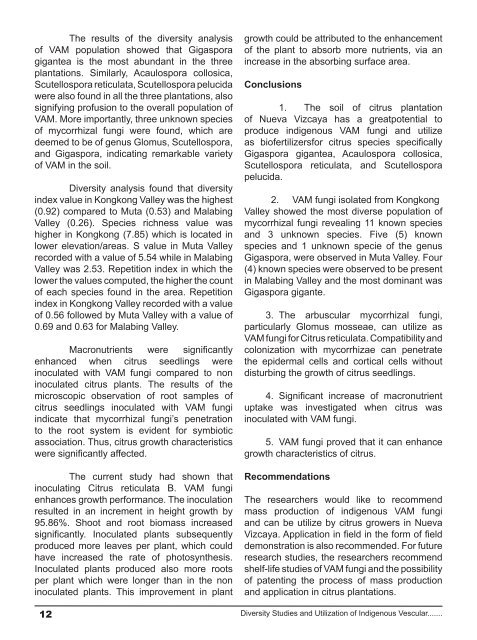download the full article here - EISRJC
download the full article here - EISRJC
download the full article here - EISRJC
Create successful ePaper yourself
Turn your PDF publications into a flip-book with our unique Google optimized e-Paper software.
The results of <strong>the</strong> diversity analysis<br />
of VAM population showed that Gigaspora<br />
gigantea is <strong>the</strong> most abundant in <strong>the</strong> three<br />
plantations. Similarly, Acaulospora collosica,<br />
Scutellospora reticulata, Scutellospora pelucida<br />
were also found in all <strong>the</strong> three plantations, also<br />
signifying profusion to <strong>the</strong> overall population of<br />
VAM. More importantly, three unknown species<br />
of mycorrhizal fungi were found, which are<br />
deemed to be of genus Glomus, Scutellospora,<br />
and Gigaspora, indicating remarkable variety<br />
of VAM in <strong>the</strong> soil.<br />
Diversity analysis found that diversity<br />
index value in Kongkong Valley was <strong>the</strong> highest<br />
(0.92) compared to Muta (0.53) and Malabing<br />
Valley (0.26). Species richness value was<br />
higher in Kongkong (7.85) which is located in<br />
lower elevation/areas. S value in Muta Valley<br />
recorded with a value of 5.54 while in Malabing<br />
Valley was 2.53. Repetition index in which <strong>the</strong><br />
lower <strong>the</strong> values computed, <strong>the</strong> higher <strong>the</strong> count<br />
of each species found in <strong>the</strong> area. Repetition<br />
index in Kongkong Valley recorded with a value<br />
of 0.56 followed by Muta Valley with a value of<br />
0.69 and 0.63 for Malabing Valley.<br />
Macronutrients were significantly<br />
enhanced when citrus seedlings were<br />
inoculated with VAM fungi compared to non<br />
inoculated citrus plants. The results of <strong>the</strong><br />
microscopic observation of root samples of<br />
citrus seedlings inoculated with VAM fungi<br />
indicate that mycorrhizal fungi’s penetration<br />
to <strong>the</strong> root system is evident for symbiotic<br />
association. Thus, citrus growth characteristics<br />
were significantly affected.<br />
The current study had shown that<br />
inoculating Citrus reticulata B. VAM fungi<br />
enhances growth performance. The inoculation<br />
resulted in an increment in height growth by<br />
95.86%. Shoot and root biomass increased<br />
significantly. Inoculated plants subsequently<br />
produced more leaves per plant, which could<br />
have increased <strong>the</strong> rate of photosyn<strong>the</strong>sis.<br />
Inoculated plants produced also more roots<br />
per plant which were longer than in <strong>the</strong> non<br />
inoculated plants. This improvement in plant<br />
growth could be attributed to <strong>the</strong> enhancement<br />
of <strong>the</strong> plant to absorb more nutrients, via an<br />
increase in <strong>the</strong> absorbing surface area.<br />
Conclusions<br />
1. The soil of citrus plantation<br />
of Nueva Vizcaya has a greatpotential to<br />
produce indigenous VAM fungi and utilize<br />
as biofertilizersfor citrus species specifically<br />
Gigaspora gigantea, Acaulospora collosica,<br />
Scutellospora reticulata, and Scutellospora<br />
pelucida.<br />
2. VAM fungi isolated from Kongkong<br />
Valley showed <strong>the</strong> most diverse population of<br />
mycorrhizal fungi revealing 11 known species<br />
and 3 unknown species. Five (5) known<br />
species and 1 unknown specie of <strong>the</strong> genus<br />
Gigaspora, were observed in Muta Valley. Four<br />
(4) known species were observed to be present<br />
in Malabing Valley and <strong>the</strong> most dominant was<br />
Gigaspora gigante.<br />
3. The arbuscular mycorrhizal fungi,<br />
particularly Glomus mosseae, can utilize as<br />
VAM fungi for Citrus reticulata. Compatibility and<br />
colonization with mycorrhizae can penetrate<br />
<strong>the</strong> epidermal cells and cortical cells without<br />
disturbing <strong>the</strong> growth of citrus seedlings.<br />
4. Significant increase of macronutrient<br />
uptake was investigated when citrus was<br />
inoculated with VAM fungi.<br />
5. VAM fungi proved that it can enhance<br />
growth characteristics of citrus.<br />
Recommendations<br />
The researchers would like to recommend<br />
mass production of indigenous VAM fungi<br />
and can be utilize by citrus growers in Nueva<br />
Vizcaya. Application in field in <strong>the</strong> form of field<br />
demonstration is also recommended. For future<br />
research studies, <strong>the</strong> researchers recommend<br />
shelf-life studies of VAM fungi and <strong>the</strong> possibility<br />
of patenting <strong>the</strong> process of mass production<br />
and application in citrus plantations.<br />
12 Diversity Studies and Utilization of Indigenous Vescular.......

















